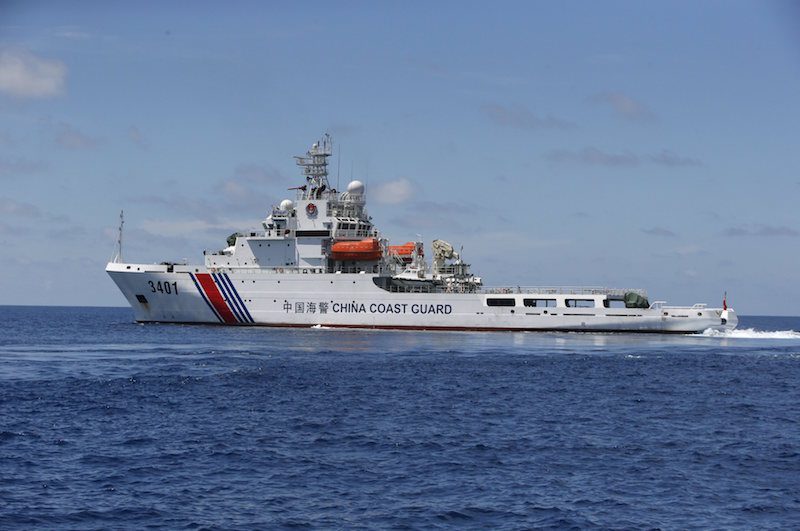A Chinese Coast Guard vessel is pictured on the disputed Second Thomas Shoal, part of the Spratly Islands, in the South China Sea March 29, 2014. Picture taken March 29, 2014. REUTERS/Erik De Castro
By David Tweed and Ditas Lopez
(Bloomberg) — China has stationed ships near a submerged reef in the South China Sea, blocking access by Philippine boats to fertile fishing grounds in the area as it steps up efforts to assert claims to more than 80 percent of one of the world’s busiest waterways.
“Many” Chinese coast guard boats and five warships were positioned around Quirino, or Jackson atoll, in the Spratly island chain, preventing Philippine boats from reaching their traditional fishery, Eugenio Bito-onon Jr., mayor of the Kalayaan municipality, said by phone Wednesday. Bito-onon said he was “alarmed” by the presence of the Chinese ships he saw on a Feb. 28 flight between Palawan and the Philippine island of Pagasa that took him over the area.
Chinese navy and coast guard vessels — identified by their gray or white colored hulls — chased Filipino fishermen from the area around Jackson atoll last week, unidentified fishermen told the Philippine Star newspaper. The ships have been positioned around the atoll, which lies between Chinese-occupied Mischief Reef and Philippine-occupied Lawak island, for more than a month, the paper said.
Land Reclamation
Under President Xi Jinping, China has reclaimed more than 3,000 acres of land on seven features in the Spratlys in the past two years, adding airstrips, lighthouses and port facilities to better project influence over the waterway. The Philippines has contested the claims based on a 1947 Chinese map known as the nine-dash line in an international tribunal, which is expected to make a ruling later this year. China has refused to participate in the arbitration.
“This is exactly the kind of thing we should expect to see more and more of as the facilities that China’s built on these artificial islands come on line,” said Gregory Poling, director of the Asia Maritime Transparency Initiative at the Center for Strategic & International Studies in Washington. “As it gets more supportive infrastructure, it is going to be much easier for China to blanket the Spratlys.”
The Philippine government is trying to verify the report about Chinese ships in the area, Department of Foreign Affairs spokesman Charles Jose said in a text message today.
The Jackson atoll is about 140 nautical miles from Palawan Island, a province that lies to the southwest of the Philippine archipelago, and about 15 nautical miles from the nearest rock that might generate a 12 nautical mile territorial zone under international law, according to Poling. Jackson atoll is fully submerged at all times, he said. “There is no rock close enough to justify a claim to this submerged reef.”
China may be building a high-frequency radar installation at Cuarteron Reef, the southern-most of the features China claims in the Spratly Islands, Poling wrote last week. China sparked new questions about its intentions in the South China Sea after surface-to-air missiles were detected last month on Woody Island, part of the Paracel Islands northwest of the Spratlys.
“The reason Chinese built out these seven features was so that it can establish effective de facto control over the sea and air space,” said Poling, “That way, even if no-one ever agrees to the validity of the nine-dash line, Beijing feels like if it can establish de facto jurisdiction and maintain that long enough, then the Southeast Asian countries will just accede to Chinese control.”
U.S. Concerned
The U.S. has said it is concerned that China is militarizing the islands and may threaten the freedom of navigation in the South China Sea, a waterway that hosts about $5 trillion of trade a year.
“China must not pursue militarization of the South China Sea,” U.S. Defense Secretary Ashton Carter in a speech in San Francisco Tuesday. “Specific actions will have specific consequences.”
Japan signed an agreement with the Philippines on Monday allowing the transfer of defense equipment. Japan has already begun building ten 40-meter coast guard vessels, regarded as civilian equipment, from official development assistance for the Philippines, and Prime Minister Shinzo Abe said last year he would “proactively consider” granting a request from the Philippines for larger patrol vessels.
© 2016 Bloomberg L.P

 Join The Club
Join The Club











